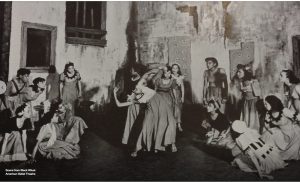Mel Tomlinson and Agnes de Mille

Mel Tomlinson got his start at Heritage Dance Theatre thanks to Agnes de Mille. In 1974, de Mille revived her company (Agnes de Mille Dance Theatre) under the name Heritage Dance Theatre, in collaboration with the University of North Carolina School of the Arts, where Tomlinson attended as an undergraduate. Tomlinson remembers in his memoir, Beyond Mr Dreams, that he was initially cut from Agnes de Mille’s audition at school for the company, but thanks to his teacher, was given another chance, where he demonstrated his many tricks, such as riding a unicycle and twirling a baton. Afterwards, Tomlinson was selected as a principal dancer in this company and began touring right after graduation. Agnes de Mille created a ballet called Texas Fourth, in which Tomlinson had multiple solo moments to show off his tricks. The ballets showcased while the company was on tour were true to the American spirit, thanks to de Mille’s fascination with The West; this connected Americans with the ballet world and the history of the nation. Agnes de Mille and Mel Tomlinson shared a rather special connection while on tour because, as the company was moving through the deep South, there were plenty of people that were unfriendly towards Tomlinson and the three other Black dancers. So de Mille took it upon herself to protect them. The tour culminated in a performance at the Metropolitan Opera House in New York City’s Lincoln Center for a gala.
Lavinia Williams and Agnes de Mille

The American Negro Ballet disbanded in 1940, so Williams went to dance with the Ballet Theatre’s Negro Unit, where she was given the opportunity to perform in Agnes de Mille’s Black Ritual. The ballet, alternatively called Obeah, was a ballet based on North American understandings of the West Indian belief in black magic.
On January 22, 1940, Agnes de Mille choreographed the ballet Black Ritual (Obeah) for sixteen Black dancers: Lawaune Kennard, Lavinia Williams, Anne Jones, Dorothy Williams, Elizabeth Thompson, Evelyn Pilcher, Edith Ross, Valerie Black, Leonore Cox, Edith Hurd, Mabel Hart, Maudelle Bass, Clementine Collinwood, Carrole Ash, Bernice Willis, and Muriel Cook. Black Ritual was set to the score “La Création du monde” (1923) by Darius Milhaud.
See also:
1940: Negro Unit of Ballet Theatre Was Founded, MoBBallet

American Ballet Theatre Negro Unit’s Black Ritual and Agnes de Mille
At the inception of the Ballet Theatre, American dancer and choreographer Agnes de Mille was recruited by co-founder of the company Richard Pleasant to choreograph, but only under the condition that de Mille not perform in any of her ballets. De Mille, who was unhappy with this constraint, noted: “Since I was not permitted to perform myself, I avoided comedy altogether in an impulse of stubborn negation and sought to do something as uncharacteristic and surprising as possible—an exotic work for Negroes” (Beacham).
De Mille ultimately created the only ballet that the Negro Unit of Ballet Theatre would perform. The work was called Black Ritual or Obeah, which would become one of de Mille’s most significant choreographic works despite often being overlooked.
De Mille selected sixteen Black female dancers for the performance, all of whom were professionally trained. These dancers were Lawaune Kennard, Lavinia Williams, Anne Jones, Dorothy Williams, Elizabeth Thompson, Evelyn Pilcher, Edith Ross, Valerie Black, Leonore “Azelean” Cox, Edith Hurd, Mabel Hart, Maudelle Bass, Clementine Collinwood, Carole Ash, Bernice Willis, and Muriel Cook.
American Ballet Theatre’s The Four Marys and Agnes de Mille
As one of over a dozen collaborations with American Ballet Theatre, for the 25th Anniversary season, Agnes de Mille choreographed The Four Marys, a piece by Trude Rittman based loosely on The Ballad of Mary Hamilton, a 16th century Scottish song about an attendant to Mary Stuart, Queen of Scots. De Mille transports the story to the ante-bellum South, placing emphasis on a relationship between a white suitor and a Black maid rather than a king and a lady-in-waiting.
Trude Rittman and Agnes de Mille
In 1941, de Mille began a series of collaborations with her friend Trude Rittman, primarily working together on various influential Broadway productions, including having Rittman arrange music for de Mille’s dances in Carousel. Rittman went on to work with de Mille on several other pieces, including The Four Marys, Brigadoon, Paint Your Wagon, and The Girl in Pink Tights. Additionally, de Mille appointed Rittman the music supervisor for the Agnes de Mille Dance Theatre before its National tour.
Sylvester Campbell and Agnes de Mille
Agnes de Mille first met Sylvester Campbell at a competition, in which Campbell competed and placed in and de Mille was judge, in Russia in 1969. After the conclusion of the competition in an elevator of a hotel in Moscow, de Mille recognized Sylvester. They struck up a conversation that ended in de Mille convincing Campbell to go back to the states as a classical dancer because it was what the people were missing. She greatly admired his style of dance and presence as a dancer. At her recommendation, Campbell returned to North America but would end up in Canada with the Royal Winnipeg Ballet.
More about Agnes de Mille

Agnes de Mille was born in New York City into a well-connected family of theater professionals. She had a love for acting and originally wanted to be an actress. She was “not pretty enough,” so she turned her attention to dance. As a child, she had longed to dance, but dance at this time was considered more of an activity, rather than a viable career option, so her parents refused to allow her to dance. She did not seriously consider dancing as a career until after she graduated from college. When de Mille’s younger sister was prescribed ballet classes to cure her flat feet, de Mille joined her. But de Mille lacked flexibility and technique and did not have a dancer’s body. Classical ballet was the most widely known dance form at this time, and de Mille’s apparent lack of ability limited her opportunities. She taught herself how to dance by watching film stars on the set of her father’s Hollywood productions; these were more interesting for her to watch than perfectly turned out legs, and she developed strong character work and compelling performances.
De Mille arrived in New York in 1938 and later began her association with the fledgling American Ballet Theatre (then called the Ballet Theatre) in 1939. One of de Mille’s most overlooked but important pieces was Black Ritual or Obeah, which she began choreographing for the newly formed Ballet Theatre’s first season. Lasting 25 minutes, this performance was created for the “Negro Unit” of the dance company and was performed by 16 Black female dancers. This was the first representation of Black dancers in a New York ballet performance within the context of a dominantly white company. Therefore, although it was only performed three times before being disbanded, Black Ritual was an unprecedented performance and played a significant role in the history of the ballet industry of the country. While white people often had misconceptions about Black dancers and the styles they would arbitrarily be best in, this performance forced them to contemplate and reevaluate these thoughts about the ways in which Black people danced.
Later on, after her success with Rodeo (a ballet she choreographed in 1942), de Mille was hired to choreograph the musical Oklahoma! (1943). De Mille went on to choreograph over a dozen other musicals. Her love for acting played a very important role in her choreography. De Mille revolutionized musical theatre by creating choreography that not only conveyed the emotional dimensions of the characters but enhanced the plot. Her choreography, as a reflection of her awareness of acting, reflected the angst and turmoil of the characters instead of simply focusing on a dancer’s physical technique.
In 1973, de Mille founded the Agnes de Mille Dance Theatre, which she later revived as Heritage Dance Theatre.
De Mille developed a love for public speaking, becoming an outspoken advocate for dance in America. She spoke in front of Congress three times: once in the Senate, once in the House of Representatives, and once for the Committee for Medical Research.
Sources:
Agnes de Mille, Wikipedia
Agnes de Mille Vault, Playbill
Agnes de Mille, Andros on Ballet

Casey Monteiro and Soffia Smedvig
Ryan Crants and McClain Groff


